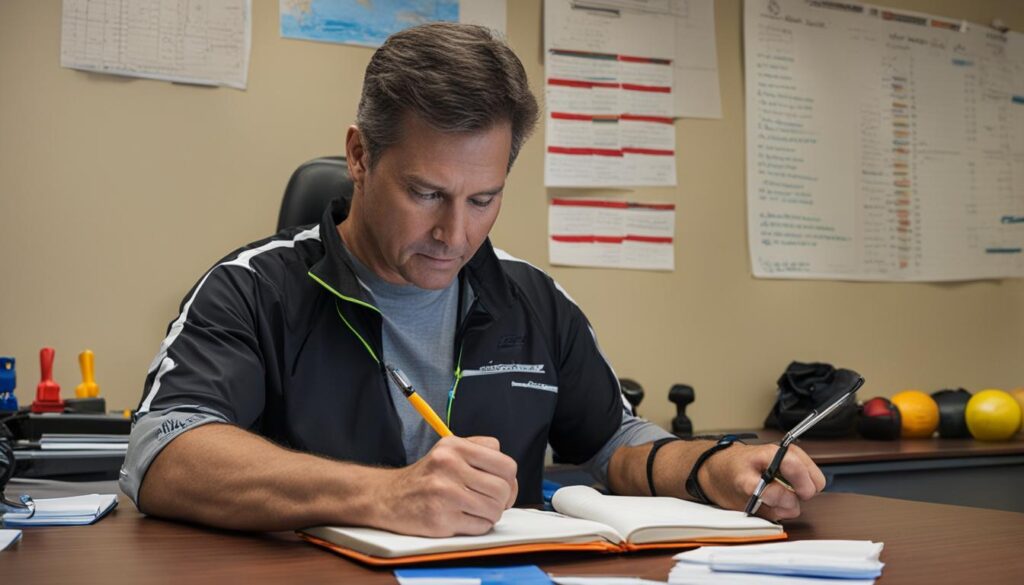Welcome to our article on periodized training plans for kayakers. If you’re a competitive kayaker looking to improve your performance, this is the right place for you. In this article, we will explore the concept of periodization in training plans for kayakers and discuss how it can help you reach your goals on the water. Whether you are a beginner or an experienced paddler, understanding and implementing a periodized training schedule can take your kayaking skills to the next level.
Periodization is a systematic approach to training that involves dividing your training program into specific periods or phases, each with a different focus. By varying the training intensity, volume, and rest periods, you can optimize your training and ensure consistent progress. In competitive kayaking, periodized training plans have been proven to be effective in improving aerobic fitness, power output, and endurance performance.
Key Takeaways:
- Periodization is a systematic approach to training that involves dividing your training program into specific periods or phases.
- By varying training intensity, volume, and rest periods, you can optimize your training and ensure consistent progress.
- Periodized training plans for kayakers have been proven effective in improving aerobic fitness, power output, and endurance performance.
- Implementing a periodized training schedule can help kayakers of all levels reach their full potential and excel in competitive paddling.
- Consulting with a professional coach or trainer can help you design a personalized periodized training plan tailored to your specific goals and needs.
The Importance of Periodization in Kayak Training
Developing a training plan for kayaking requires a systematic approach that considers the unique demands of the sport. This is where periodization techniques come into play. Periodization is a structured training method that involves dividing the training program into distinct periods or phases, each with a specific focus. It allows kayakers to target different fitness components and progressively build their skills and endurance.
By incorporating periodization into their training, kayakers can ensure a well-rounded development of their athletic abilities. This includes improving cardiovascular fitness, power output, flexibility, technique, and overall performance. Each phase of the training plan has a specific purpose, designed to challenge the body in different ways and promote adaptation.
“Periodization is a systematic approach to training that involves varying the training program at regular intervals to optimize performance.”
With periodization, kayakers can also prioritize recovery and avoid overtraining. By including rest periods and deloading phases, the body has time to adapt and recover, reducing the risk of injury and preventing burnout. Periodization ensures a balanced and progressive approach to training, allowing for constant improvement and peak performance when it matters most.

Table: Periodization Phases in Kayak Training
| Phase | Focus | Duration |
|---|---|---|
| Base | Develop aerobic base and overall conditioning | 4-6 weeks |
| Strength | Focus on building muscular strength and power | 4-6 weeks |
| Power | Train explosive power and speed | 3-4 weeks |
| Endurance | Enhance endurance capacity | 4-6 weeks |
| Taper | Reduce training load and allow for recovery before competition | 1-2 weeks |
Table: Periodization Phases in Kayak Training
Periodization is not just a buzzword in the world of kayaking; it is a proven strategy for developing athletes to their fullest potential. By implementing a periodized training plan and following the structured phases, kayakers can optimize their performance and achieve their goals on the water.
Traditional Periodization vs Block Periodization
When it comes to advanced training cycles for kayakers, two popular approaches are traditional periodization (TP) and block periodization (BP). These models offer different strategies for structuring periodized workout routines and maximizing performance gains in paddling.
| Traditional Periodization (TP) | Block Periodization (BP) |
|---|---|
| Simultaneous development of multiple fitness components within a regular workload distribution | Focuses on highly concentrated training loads in specific training cycles called blocks |
| Provides multi-peak performances and maintains residual training effects | Allows for consecutive development of a minimal number of motor and technical abilities |
| Well-suited for athletes aiming to peak at specific competitions throughout the year | Effective for improving performance in certain variables related to kayaking |
Traditional periodization has been the dominant model in sports training for several decades. It focuses on developing various fitness components simultaneously, allowing athletes to peak at different points in the competition calendar. However, traditional periodization has its limitations, such as difficulty in maintaining residual training effects and providing multi-peak performances.
Block periodization, on the other hand, takes a more concentrated approach. It involves dividing the training into specific blocks, where athletes primarily focus on a minimal number of motor and technical abilities. This targeted approach allows for greater specialization and enhancement in certain variables related to kayaking.
Overall, the choice between traditional periodization and block periodization depends on several factors, including an athlete’s competition schedule, training goals, and performance needs. Both models have their advantages and can be effective in achieving advanced training cycles and periodized workout routines for paddlers.
The Science Behind Periodization
Structured training is crucial for competitive paddling, and that’s where periodization comes into play. Understanding the science behind periodization can help you plan and execute an effective kayaking training cycle. Periodization is based on the General Adaptation Syndrome (GAS), which explains how the body responds to stress. The three stages of GAS – alarm, resistance, and exhaustion – form the foundation of periodization.
During the alarm stage, the body recognizes the stress and initiates a response. In the context of training, this is when you challenge your body with new exercises or increase the intensity or volume of your workouts. The resistance stage is where the body adapts to the stress and begins improving its performance. This is where the magic of periodization happens. By manipulating the volume and intensity of your workouts over specific periods of time, you can keep your body in this resistance stage, ensuring continual progress and improvement.
The final stage, exhaustion, occurs when the body is overwhelmed by prolonged stress without adequate recovery. This is something you want to avoid as it can lead to overtraining and increased risk of injury. The goal of periodization is to prevent exhaustion and maintain the body in the resistance stage for as long as possible.
Planning Your Kayaking Training Cycle
When planning your kayaking training cycle, it’s important to consider your individual needs, goals, and competition schedule. A well-designed periodized training plan takes into account your experience level, genetics, physical ability, and desired outcomes. By breaking your training into distinct phases or cycles, you can focus on developing specific fitness components such as aerobic fitness, power output, and endurance performance.
Each phase of your training cycle will have a specific goal and training focus. For example, during the base phase, you may focus on building a solid foundation of aerobic fitness and technique. As you progress into the strength and power phases, the emphasis will shift towards building muscle strength and explosive power. Finally, the taper phase allows for recovery and consolidation before a competition.
Monitoring your performance throughout the training cycle is essential for making adjustments and ensuring progress. By tracking your workouts, analyzing your results, and listening to your body, you can fine-tune your training plan to maximize your performance on the water.
| Phase | Goal | Focus |
|---|---|---|
| Base | Build aerobic fitness and technique | Long, steady-state paddling and technique drills |
| Strength | Develop muscle strength | Resistance training and high-intensity intervals |
| Power | Improve explosive power | Sprints and plyometric exercises |
| Taper | Recover and consolidate | Decreased volume and intensity |
By understanding the science behind periodization and implementing a well-structured training plan, you can optimize your performance as a competitive paddler. Periodization allows you to systematically progress through different training phases, target specific fitness components, and prevent overtraining. So, take the time to plan your kayaking training cycle and reap the rewards on the water.
Designing a Periodized Training Plan for Kayakers
When it comes to creating a periodized training plan for kayakers, there are several important factors to consider. The plan should be tailored to the individual athlete’s needs, taking into account their experience level, genetic predispositions, and training goals. By customizing the program, you can ensure that it effectively targets the specific areas that need improvement and promotes overall performance enhancement.
One common approach to periodization is linear periodization, where training progresses gradually from one phase to the next, with each phase focusing on different aspects of fitness and technique. This type of periodization provides a structured and systematic way to develop key athletic abilities and allows for continuous adaptation and improvement.
Another approach is block periodization, which involves concentrated training blocks that emphasize specific training goals. This model is often used by elite athletes and focuses on the consecutive development of a minimal number of motor and technical abilities. Block periodization can be particularly effective for kayakers who have already reached a high level of training and need to target specific areas of their performance.
To ensure the success of a periodized training plan, it is crucial to progressively increase the training load, intensity, and duration throughout the plan. This gradual progression allows the body to adapt and grow stronger over time, leading to improved performance on the water. It is also essential to include periodic periods of decreased load for recovery and consolidation, as this helps prevent overtraining and reduces the risk of injury.
| Phase | Focus | Duration |
|---|---|---|
| Base Phase | Building aerobic fitness and endurance | 4-6 weeks |
| Strength Phase | Developing power and muscular strength | 4-6 weeks |
| Technique Phase | Improving paddling technique and stroke efficiency | 4-6 weeks |
| Competition Phase | Focusing on race-specific skills and tapering | 2-4 weeks |
By following these periodization strategies and designing a well-structured training plan, kayakers can optimize their performance and achieve their goals in competitive paddling. Remember to monitor performance, make adjustments based on feedback and progress, and stay committed to the plan. With dedication and consistency, a periodized training program can help you reach your peak performance and excel in the world of kayaking.
Implementing a Periodized Training Plan for Kayakers
Implementing a periodized training plan is crucial for kayakers looking to optimize their performance on the water. By following a structured training program, you can target specific aspects of fitness and technique, leading to improved endurance, power, and technical skills. Here are some key steps to effectively implement a periodized training plan:
- Commitment and Consistency: Stay dedicated to the planned training cycles and phases. Consistency is essential for progress and development.
- Adjusting Load and Intensity: Listen to your body and make adjustments to the training load and intensity as needed. This ensures that you’re challenging yourself without risking overtraining or injury.
- Varied Workouts: Incorporate different workouts into your weekly training plan to target different aspects of fitness and technique. This variety helps keep your training engaging and effective.
- Recovery Periods: Allow for proper recovery periods in your training plan. These periods of rest are crucial for your body to adapt and recover from the training stress.
- Monitoring and Adjustments: Continuously monitor your performance and progress. Make adjustments to your training plan based on feedback and results to ensure continued improvement.
Remember, implementing a periodized training plan is not a one-size-fits-all approach. Tailor the plan to meet your individual needs, taking into account your experience level, genetic predispositions, and training goals. With a well-designed and properly implemented periodized training program, you can maximize your potential as a competitive kayaker.

Advantages of Periodization for Kayak Training
Implementing a periodized training plan offers numerous advantages for competitive kayakers. By structuring your training program using periodization techniques, you can optimize your performance and achieve your goals in the sport of kayaking. Here are some key benefits of incorporating periodization into your training regimen:
- Progressive development of fitness components: Periodization allows you to systematically develop different aspects of your fitness, such as aerobic capacity, power, and endurance. By dividing your training into distinct cycles and phases, you can target specific areas of improvement and steadily enhance your overall performance.
- Targeting weaknesses: With periodization, you can identify and focus on your specific weaknesses as a kayaker. Whether it’s improving your technique, building strength in certain muscle groups, or enhancing your paddling efficiency, periodization allows you to tailor your training program to address these areas of improvement.
- Prevention of overtraining and injury: By incorporating planned recovery periods into your training plan, periodization helps prevent overtraining and reduces the risk of injuries. These recovery periods are essential for your body to adapt and recover from the stress of training, ensuring you can maintain high levels of performance without compromising your health.
- Systematic progression: A periodized training program enables you to gradually increase the intensity, duration, and complexity of your workouts over time. This systematic progression helps you continually challenge your body and stimulate adaptations, leading to continual improvement in your kayaking performance.
Overall, a well-designed periodized training program provides structure, focus, and optimization to your kayaking training. It allows you to target specific aspects of your fitness, prevent injuries, and steadily progress towards your competitive goals. By implementing periodization techniques, you can maximize your potential and become a stronger, more efficient kayaker.
| Advantages of Periodization for Kayak Training | Benefit |
|---|---|
| Progressive development of fitness components | Enhance all aspects of your athletic ability |
| Targeting weaknesses | Focus on improving specific areas of performance |
| Prevention of overtraining and injury | Maintain optimal performance while reducing the risk of injuries |
| Systematic progression | Continually challenge your body and stimulate adaptations |
Conclusion
In conclusion, periodized training plans are crucial for competitive kayakers looking to maximize their performance on the water. By implementing a well-designed periodization strategy, kayakers can optimize their training and systematically develop their fitness components, including aerobic capacity, power output, and endurance performance.
Both traditional periodization and block periodization are effective models for structuring a kayaking training plan. While traditional periodization allows for the simultaneous development of multiple fitness components, block periodization focuses on concentrated training loads in specific cycles, leading to improved performance in key variables related to kayaking.
With the use of periodization, kayakers can strategically target their weaknesses, continually progress their skills, and reduce the risk of overtraining and injury by incorporating necessary recovery periods. By following a periodized training plan and monitoring their progress, kayakers can achieve their peak performance and excel in competitive paddling.
FAQ
What is periodization in training?
Periodization is a systematic approach to training that involves varying the training program at regular intervals to optimize performance.
Why is periodization important for kayakers?
Periodization is essential for developing all aspects of athletic ability, including cardio, power, flexibility, technique, and artistry in kayaking.
What is the difference between traditional periodization and block periodization?
Traditional periodization involves the simultaneous development of multiple fitness components, while block periodization focuses on highly concentrated training loads in specific training cycles called blocks.
What are the stages of the General Adaptation Syndrome (GAS)?
The stages of GAS are alarm, resistance, and exhaustion, and they play a crucial role in the training process.
How should a periodized training plan be designed for kayakers?
A periodized training plan for kayakers should consider an athlete’s experience, genetics, physical ability, and goals, and be divided into cycles and phases focusing on different fitness components.
How can a periodized training plan be implemented for kayakers?
Implementing a periodized training plan requires commitment, consistency, adjusting the training load and intensity as needed, including specific workouts targeting different aspects of fitness and technique, and incorporating recovery periods.
What are the advantages of periodization for kayak training?
Periodization allows for progressive development of fitness components, prevention of overtraining and injuries, and enhanced endurance, power, and technical skills in competitive kayaking.





